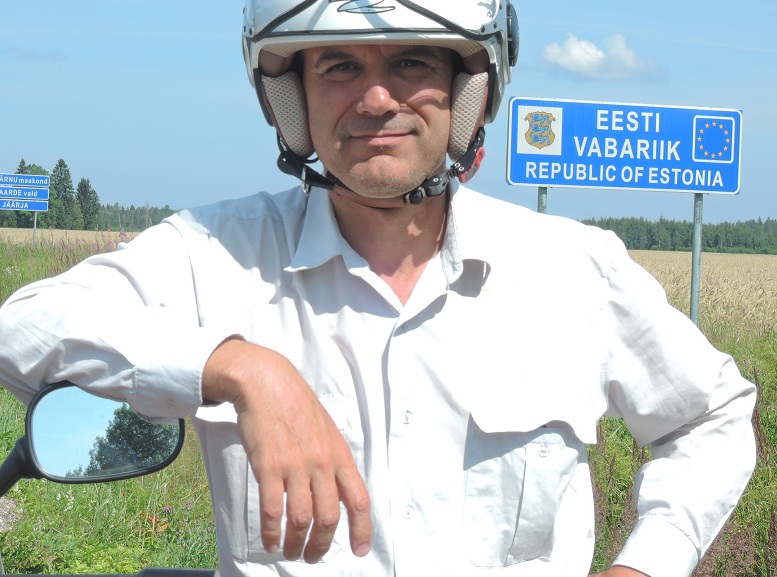Coming from Latvia, my first impressions about Estonia were: this is really where Scandinavia begins; this, and not the Gulf of Finland, is Eastern Europe’s true north border; Estonia isn’t actually a Baltic state but a nordic country — or at least something in between both worlds.
On one hand, crossing this border means to leave behind the post-communist poverty, so palpable along the old Soviet influential area. The contrast between Estonia and Latvia is sensibly bigger than between the latter and Lithuania, which in turn isn’t very different from Poland. One can easily realize this contrast from the roads shape, the buildings, streets and houses, from the farming machinery, the cars and trucks, traffic signs, the commerce, the goods supply and –of course– the prices; but also from people’s manners, their not so insular character, their more respectful driving habits, the English level, and certainly from their mother tongue, Estonian being closely related with Finnish. Even –despite its more continental location– this country’s gas stations are registered under their northern neighbour’s oil companies across the sea, Lukoil brand giving way to Neste Oil, the Finn giant.
In the previous chapter I was spending the night in the quiet town of Mazsalaca, not knowing whether or not the next day I’d have to ride along another stretch of dirt road to the Estonian border or even further on, my offline maps drawing in white (i.e. unpaved) all the northward routes around my location. But in the morning, a very nice and serviceable worker who was doing some job in the backyard managed to tell me by sign language –not knowing a single word of English– that the road to the border was all paved; so I thanked him and, relying on his information, rode on, venturing straight to Estonia. Not without a fleeting sadness I left behind the small and endearing Latvian State, its quiet border town Mazsalaca.
Fortunately I soon learnt that my informant wasn’t mistaken: the road was candy and, though narrow, the asphalt was brand new at both sides of the border, so that before I could realize, I was already riding the motorcycle on a somewhat busier road. Socially and economically, Estonia may well be regarded in between the Scandinavian, Baltic and Slavic worlds; though when directly asked, they told me they didn’t feel in the least Slavic. Truth is, however, that 30% of Estonians are native Russians, and two thirds of the population speak fluent Russian. Like in Latvia and Lithuania, once again we meet here with Russian as the second de facto language. As a matter of fact, and despite russophobes, Russian is –rather than English– the lingua franca when they need to understand one another among the three Baltic States, their respective official languages having nothing to do with each other, as they belong to totally different families.
My first day in Estonia I made little progress because, upon stopping in Viljandi for having lunch and visiting the town, I came across a modest and sober hostel located at a lovely corner right downtown, and I fancied to stay overnight. It’s run by some neighbours’ association for helping the elderly and tended by a few ladies, volunteers who make shifts at reception.
Despite its scant population, Viljandi is a relevant town thanks to History and to holding the remains of the biggest medieval fortress-hill in Baltic regions, and also for being Estonia’s Cultural Capital, with an active theatre and an international Folk Music Festival. Chance had it so that I arrived precisely on the eve of its opening this year. However, not being a crowd lover nor a fan of folk music, I didn’t extend my stay any longer for attending the event. I was happy with doing some sightseeing: the same day of my arrival I explored the well preserved old town, full of beautiful, decaying wooden houses, the bizarre fortress ruins on its hilltop emplacement and the ancient villas on the lake-looking hillside.
After my tour, I dined a salad in a bright terrace by the hostel, shaded by tall leafy trees whose foliage cooled down the hot summer day’s air underneath; and then, yet before the late dusk fell, I went for a beer to a large, snugly furnished double-decked bar, all in wood, whose bar tender was as good looking as she was badly skilled. And this is where Estonia still lags behind Finland: not having learnt yet how to serve customers, they keep the communist mentality according to which, out of goods shortage, it’s the clients who must thank the business-owners for providing them with something to buy or eat…
A last side note for this chapter: the menus in most restaurants along the whole old Soviet Union (and influence area) are full of Russian dishes, no matter how much the newly independent countries loath their former oppressors. You can trick information and mislead people, but you can’t fool time nor real history.

